15/
Honda
Grrr
Wieden + Kennedy London
The Honda Grrr ad started with a song. The 90-second-long television and cinema spot, by Wieden + Kennedy in London, forms part of The Power of Dreams series of commercials for the Japanese car brand, a set of ads that are notable for wildly varying in style. Grrr followed Cog, a hugely successful ad for the Honda Accord that featured an elegant chain reaction of car parts (see previous ad). By contrast to the restrained sophistication of Cog, Grrr is brash and exciting, incorporating psychedelic animated visuals and a jaunty tune. The aim of the ad was to promote Honda’s new i-CTDi diesel engines.
Despite the fact that Honda designer Kenichi Nagahiro had designed the new engine from scratch, Wieden + Kennedy were pitching to a tough audience, who at the time were deeply suspicious of diesel. Rather than ignore this resistance, the creatives addressed it directly, and introduced the notion of ‘positive hate’ in an attempt to get audiences to rethink their views. ‘With each ad you want to see a different aspect of the Power of Dreams,’ explains Grrr writer Michael Russoff, ‘so that gives you licence to do something different each time – you’re meeting the power of dreams from a slightly different viewpoint. So the power of dreams in this case could be about positive hate – doing something, making something, ripping something apart, changing it. Whereas in Cog the power of dreams was a fine, beautifully constructed, well-made power of dreams.’
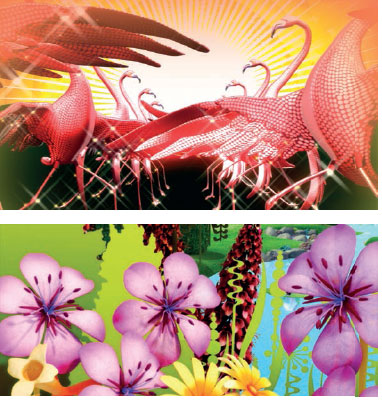
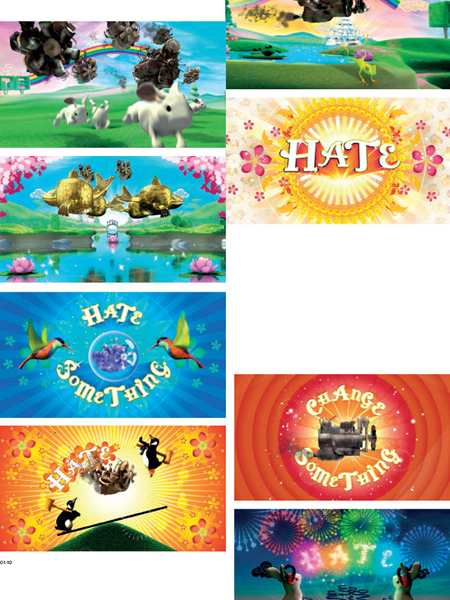
01-10 Stills from the finished commercial reveal the bright colours and general exuberance of the Honda Grrr ad. The ad was 90 seconds in length and set to a song performed by Garrison Keillor.
‘With each ad you want to see a different aspect of the Power of Dreams, so that gives you licence to do something different each time – you’re meeting the power of dreams from a slightly different viewpoint.’

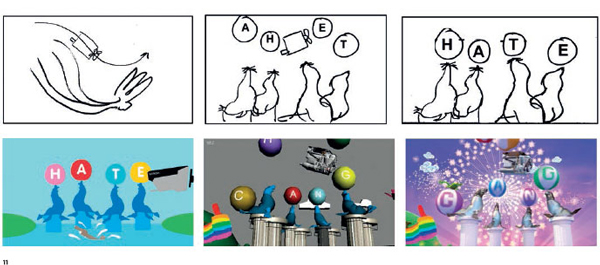
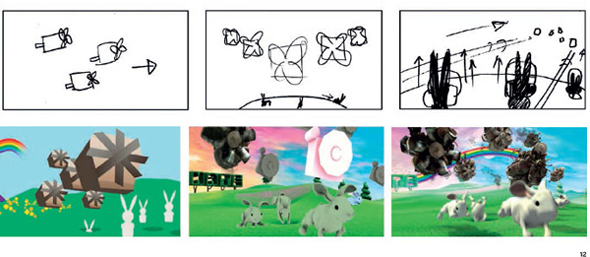
11-12 Images by Honda Grrr’s directors, Smith & Foulkes, show how the animation for the ad was slowly developed.

13 Sketch from a very early storyboard for the ad, by creatives at the ad agency Wieden + Kennedy London.
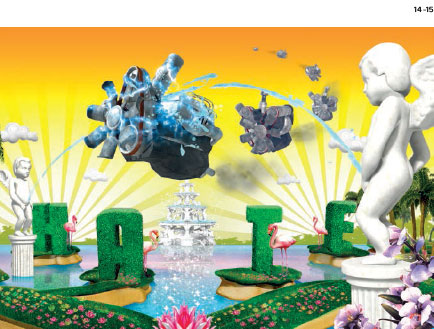
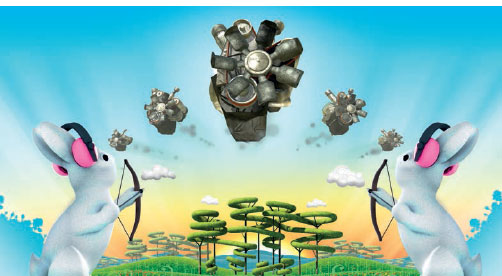
14-15 Images sent by the directors to the ad agency as part of their pitch to work on the ad. Included in their early suggestions was an idea to have boy statues pissing on the engines, though this was dropped from the final spot.
Grrr features bunnies, seals and rainbows changing a set of old, smoky diesel engines into the shiny new Honda version, all set to a deeply catchy soundtrack. ‘It was always going to be musical,’ continues Russoff. ‘We were thinking, “how do we make people excited about something like a diesel engine? We could do a song.… We could do the greatest jingle that’s ever been done, we could take people with us.” The musical thing felt like a good way of doing it. We didn’t want it to be aggressive hate. We thought music could take the edge off.’
The song in the ad is written by Russoff, and invites us to ‘hate something, change something, make something better’. Although in this instance the sentiment applies to the diesel engine, part of the song’s charm is that its expression could refer to any number of situations. In talking about the writing process, Russoff makes it seem simple. ‘I remember trying out some songs I’d written already, and in one of them, which had completely different lyrics, “hate something, change something” just fitted.… The atmosphere felt folksy, warm and charming. Then we just wrote a couple more verses and Bob’s your uncle!’
‘We took a guitar into the meeting with the client,’ Russoff continues, ‘I don’t think they’d had that before. We performed it. I think you have to go for it – make them feel what you feel about it. They loved it – it’s the only time I’ve been in where they’ve said “we want it to be like that, that feeling that you just had there, just make that”.’
Unusually, the creative team recorded the song before approaching any directors to work on the animation. A consistent element to the Power of Dreams ads is a voiceover by U.S. writer and broadcaster
Garrison Keillor. Usually each ad involves Keillor performing a speaking part, but here the creatives were keen that he be the one to sing the song. ‘He took a bit of convincing to sing,’ recalls Russoff. ‘I remember being very nervous about asking him; we sort of worked up to it. I knew he could sing because I’d heard him sing on other stuff. Also with the Honda ads, you always want to find something else to do with Garrison, so we thought, “let’s have him sing!”’
‘We took a guitar into the meeting with the client. I don’t think they’d had that before. We performed it. I think you have to go for it – make them feel what you feel about it. They loved it.’
‘He wasn’t sure in the beginning, and it was touch and go whether or not he’d do it. But he did it very naturally. Sean [Thompson, a creative on the ad] is whistling on it – he had a wonderfully pathetic whistle. Then we’re all backing singers. Usually with Garrison you just get a couple of takes and that’s that. You take what you’re given with him. Often that’s a good thing, because he’s got his own way of doing it. That’s not what you heard in your head… but it’s right. I think we did a few takes and that was it.’
The song opens with a spoken introduction, in which Keillor invites the audience into the story by saying ‘here’s a little song for anyone who’s ever hated, in the key of grrr’. Charming and simple, the intro in fact required quite a lot of protection by the creatives to make it in. ‘Even that little introduction felt like we were doing something a bit different,’ explains Russoff. ‘An ad has to start straight away because you only have a short amount of time… and suddenly here was this different tone to begin with. I remember really protecting that first ten seconds throughout the whole process, to keep that magical slow beginning that people aren’t expecting.’
With the song complete, the creatives began looking for an animation director to create the visuals for the ad. At this stage the storyboards by the creatives were minimal, although the notion of old engines flying through the space was in place. Such a loose visual brief, coupled with a strong soundtrack, proved popular with the directors that Wieden + Kennedy approached, and a buzz began to form around the script even at this early stage.
A number of excellent pitches were submitted, though directing team Smith & Foulkes’ ideas stood out. ‘I think we described their visual style at the time as if Liberace had designed a golf course or something,’ says Russoff. ‘It was gloriously camp and over the top, yet really charming. For their pitch they’d done some frames of hate world, and there were peeing statues [these were dropped from the final film], the engine flying through and it just looked amazing. You just looked at it and knew you hadn’t seen it before – it was a bit of a no-brainer really.’
‘Anything just silly, but really quite ornate,’ is how Smith & Foulkes describe the type of imagery they wanted to create for the ad. They cite visual references such as Chinese propaganda art, Bollywood, and, as Russoff guessed, Liberace. The directors introduced the idea of using positive imagery to turn the squadron of old diesel engines into the new Honda one. ‘It was key for us that it wasn’t just beautiful images, it was also comedy, there was humour and wit to it, and a narrative flow that you could actually follow,’ they say. The flow of the ad was in fact the only point of tension between the creatives and the directors on the job, with the creatives wanting a left-to-right, platform game-style progression, while the directors wanted to create a more expansive world. The end result contains aspects of both.
‘The web five years ago really felt five years ago and the limitations were enormous, but funnily enough that made everyone a little more creative.’
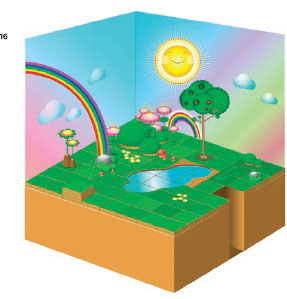
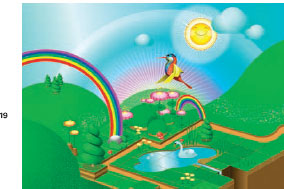
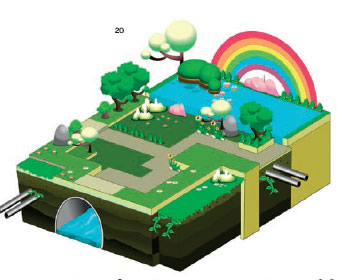

16, 19-21 Work-in-progress images for the design of the Honda Grrr game by Unit9. The game was free to play online and released at the same time as the ad.
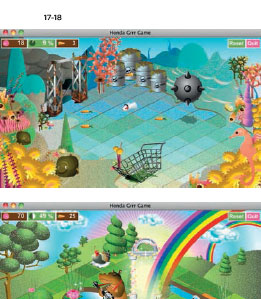
17-18 Screenshots of the finished game. The game continued the message of the ad, with players encouraged to turn bad things into good things to collect points.
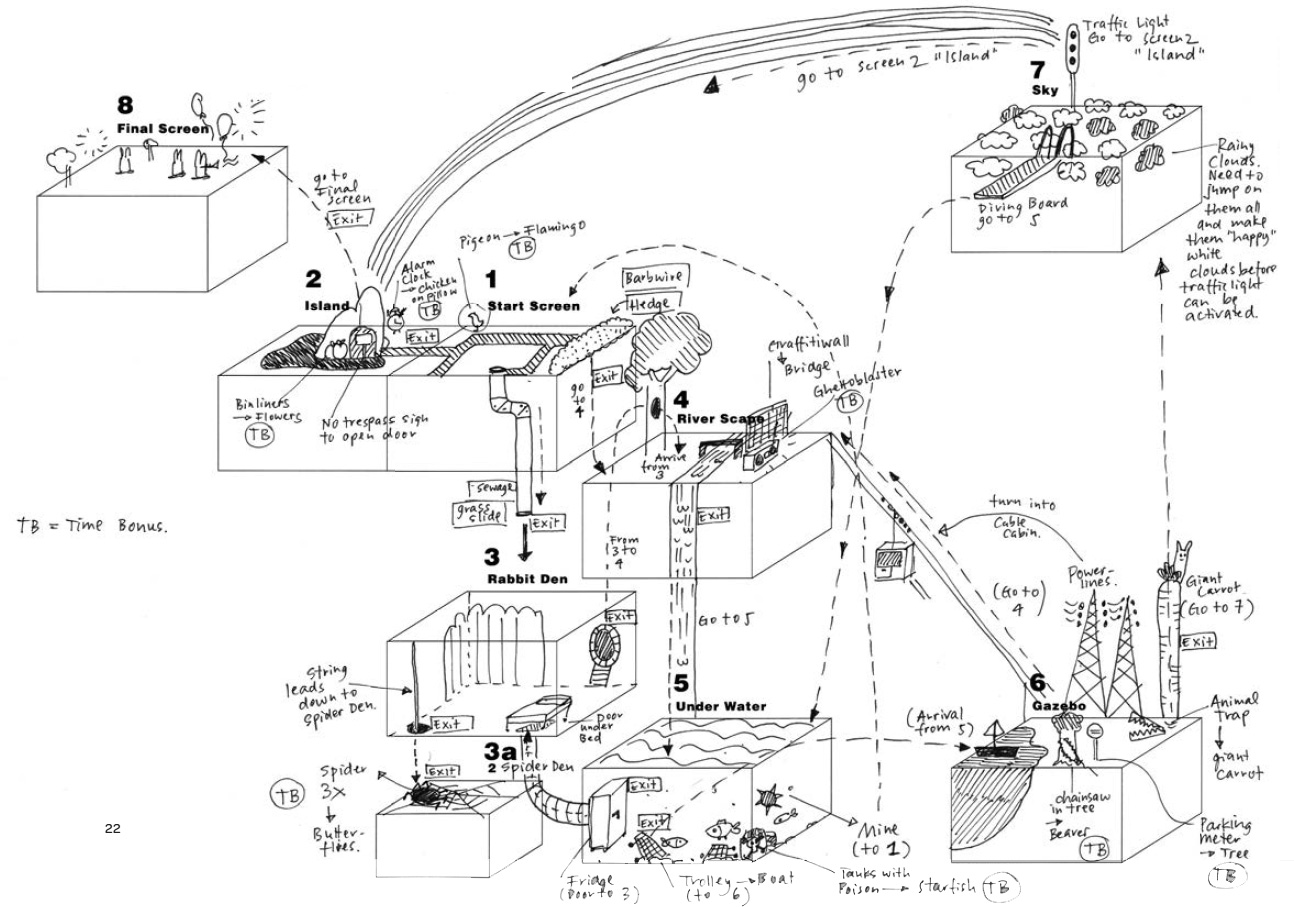
22 A sketch by Unit9 shows how the game’s detailed structure was planned.
‘I’ve never worked with directors I’ve trusted so much,’ says Russoff. ‘Maybe because it was animation. But there was so much they were doing that was right – I remember the first time I saw the rabbits with the earmuffs and thinking “that’s crazy, but great”.’ Wieden + Kennedy endeavoured to give Smith & Foulkes space to work, without breathing down their necks too much. ‘Let them be brilliant at what they’re brilliant at, give them that freedom,’ says Russoff. ‘I think if I was directing that’s what I’d want from a client. I think sometimes creatives feel a bit threatened by that. It’s just crazy – if you’re going to spend a long, hard time thinking who’s the best person to direct it, when you give them the job, give them the job. Don’t get in the way of it.’
Smith & Foulkes met regularly with the creatives to show them the development of the ad over the four-month animation process. The trust that Russoff speaks of is vital in the making of an animated work, as it is often only near the end that the full complexity of the piece will be seen. Up until then, there are only gestures of what’s to come, yet the early decisions that are made about the timing and the direction of the piece are vital, and usually final. ‘We work slightly differently from live action in a lot of ways,’ say Smith & Foulkes, ‘because we almost edit up front. Before we start on the job, the editing is from the storyboard and you make an animatic, so you get the flow. Especially when we already had the song, you could almost understand the flow of what’s happening from thumbnail sketches. And that’s what you make – as opposed to live action, where you shoot reels of stuff and then shape it into a story at the end.’
That’s not to say that animation is entirely without spontaneity. ‘Animators are like actors,’ the directors continue. ‘We have to direct them into a performance. They do stuff sometimes that’s amazing that you don’t expect, and that really works better than anything we could come up with.… Or they do it really badly and have to do it over and over again until they’ve got it right.’
Released in 2004, the commercial that resulted from this excellent working relationship wowed audiences, picking up applause from the both within the ad industry and outside. It also set a new benchmark for the use of animation in ads. ‘I think it’s interesting since Grrr came out to see how things have changed for animation in commercials generally,’ reflect Smith & Foulkes. ‘It’s tougher to make a statement like that, and for audiences to go “wow, look at that, that’s new and different”. I think it’s become tougher for animation generally to stand out and be surprising.’
The Grrrgame
In addition to the film, the Grrr campaign included print and radio commercials as well as an online presence, in particular a web game that was designed by Unit9 digital production company. The game features characters from the ads that can be manipulated around a board game-style layout. ‘The web five years ago really felt five years ago and the limitations were enormous,’ says Piero Frescobaldi, creative partner at Unit9, of working on the project. ‘But funnily enough that made everyone a little bit more creative. We decided that rather than taking the narrative, we would take the tone of voice and sense of happiness from the ad and turn it into a game where you go around changing things into other things. It was a lot harder to make than it looks – none of the work that was done for the TV commercial could actually be used in the game, because at the time resolutions were very different. We had to recreate an illustrative style that was in line with the ad, without actually being the same. That worked very well, because no one actually feels that there is too much of a difference.’ Unit9 animated the game entirely in-house, in just two weeks.
